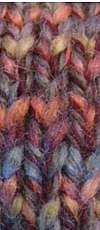Arm knitting
Arm knitting is a knitting technique which uses the knitter's arms instead of knitting needles.[1] This method of knitting gained popularity during 2013 and 2014.[2]
Process
Arm knitting typically uses yarn in a size of 6 or "extra bulky". Knitters can decide the number of skeins they want to use based on desired thickness and length. Scissors are the only other tool than the knitter's arms. Normal crafts that can be made with arm knitting are blankets, scarves, infinity scarves, and cowls. Tutorials claim that the knitter can create a scarf in thirty minutes, though it can be around an hour depending on the length and width of the scarf.[3]
- First the knitter must cast on to their arm with a slipknot and a tail. The number of stitches that are cast on determine the width of the scarf, blanket, or cowl.[4]
- After the desired number of stitches the knitting begins. The stitches are switched between both arms. This process continues until the craft is at the desired length.
- Stopping the knitting is a process known as binding off. To bind off the knitter will knit two stitches and then move the stitch closest to the body over the stitch further from the body. This process continues until all the stitches are bound off.
- Once the project has been bound off it can be sewn together to make an infinity scarf, or for blankets it can be left as is. It is also possible to create fringes on the ends of the scarf instead of making it into an infinity scarf.
gollark: ```rust let with_db = warp::any().map(move || pool.clone()); let static_files = warp::path("assets").and(warp::fs::dir("assets")); let view_page = warp::path!(String).and(warp::get()).and(with_db.clone()) // repeating the next bit for every route is kind of bad, see if it can be changed somehow .and_then(|title, db| async { error_to_http_response(view_page(db, title).await) }); let editor_page = warp::path!(String / "edit").and(warp::get()).and(with_db.clone()) .and_then(|title, db| async { error_to_http_response(editor_page(db, title).await) }); let save_edit = warp::path!(String / "edit").and(warp::post()).and(warp::body::form()).and(with_db) .and_then(|title, form, db| async { error_to_http_response(save_edit(db, title, form).await) }); let not_found = warp::any().map(|| warp::reply::with_status("404 Not Found", http::StatusCode::NOT_FOUND)); let main = editor_page.or(save_edit).or(view_page); let app = static_files.or(main).or(not_found);```See, this is how you SHOULD design routes: incomprehensibly.
gollark: no!
gollark: Your *routes* shouldn't be config. They're code. They're part of the application.
gollark: What? Why is that a config file?! You should be defining routes in your code.
gollark: Yes, that is a bit weird and not ideal.
References
- Kent, Donna (2007). Ghost Stories and Legends of Eastern Connecticut: Love, Mysteries and Secrets Revealed. Haunted America. ISBN 9781596293175.
- "23 Insanely Clever Arm Knitting Projects and Techniques". DIY & Crafts. 2014-10-06. Retrieved 2018-07-27.
- "Arm Knit an Infinity Scarf in 30 Minutes". Instructables. Archived from the original on 14 October 2014. Retrieved 20 October 2014.
- "Arm Knitting How-To Photo Tutorial // Part 1: Casting On - Flax & Twine". Flax & Twine. 2014-02-21. Retrieved 2018-07-27.
This article is issued from Wikipedia. The text is licensed under Creative Commons - Attribution - Sharealike. Additional terms may apply for the media files.
